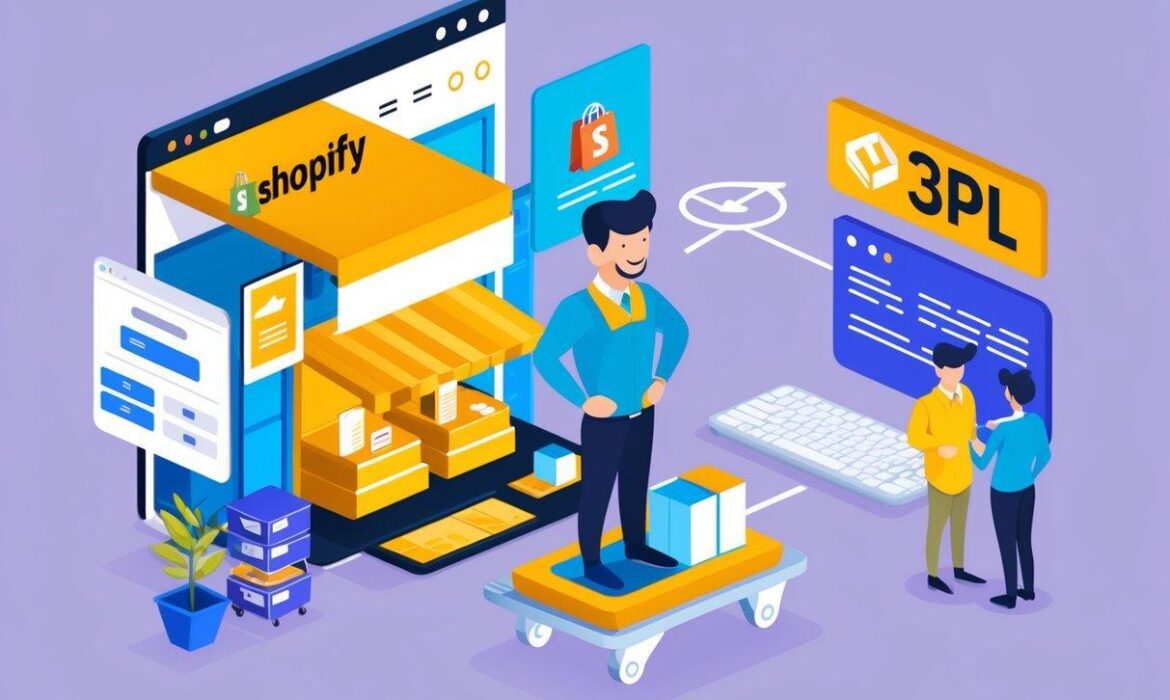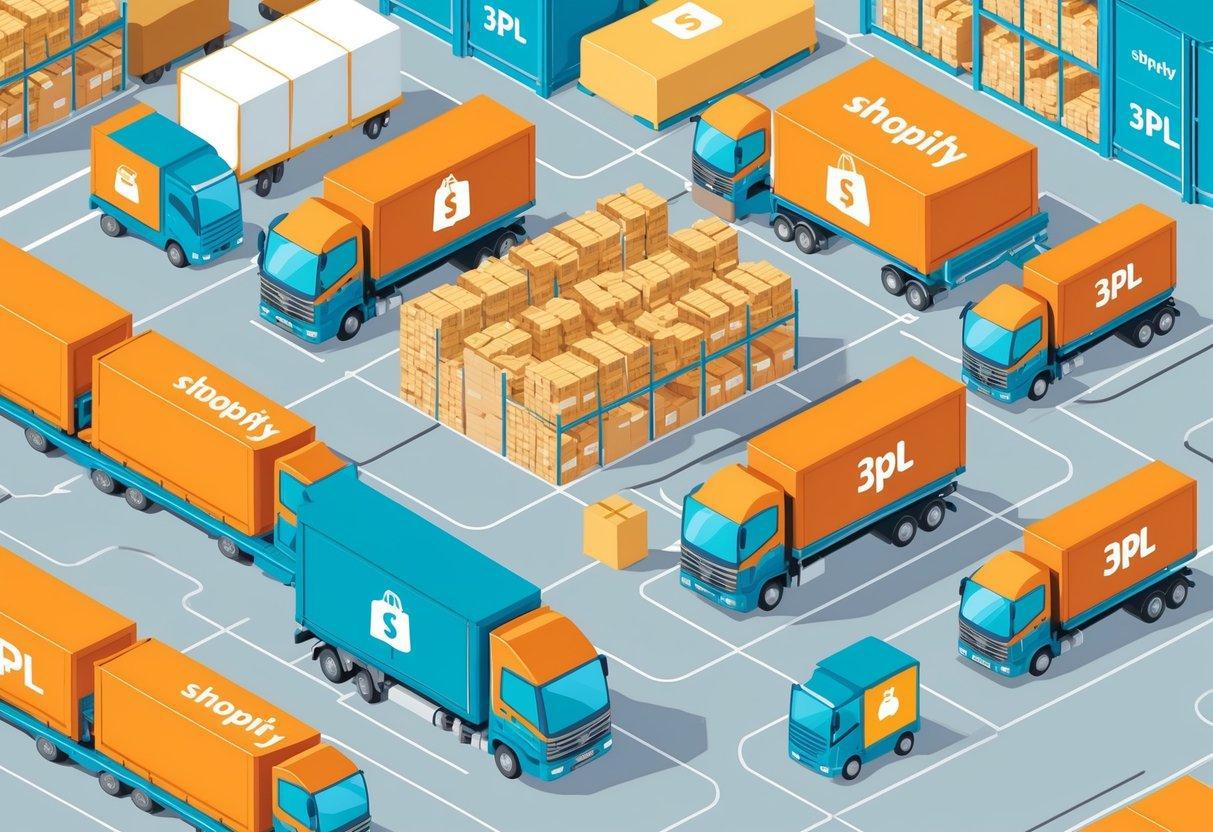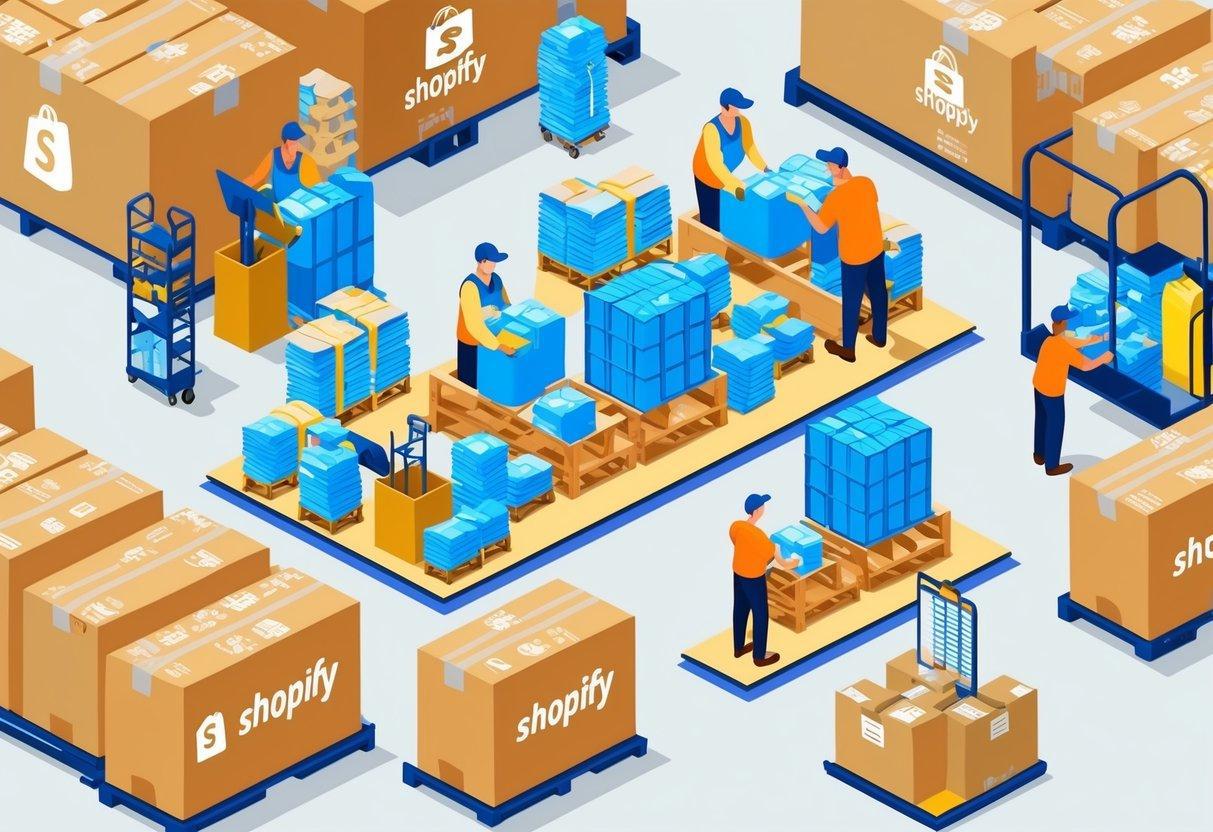Seamless Shopify 3PL Integration for Your Online Store

Is your Shopify store growth outpacing your fulfillment capabilities? As orders multiply, managing warehousing, picking, packing, and shipping in-house can pull your focus away from growing your business. Shopify 3PL integration lets you hand these operational burdens to specialists while you concentrate on creating more orders. This approach not only simplifies operations but delivers the faster, more reliable shipping experience your customers expect.
What is 3PL Integration?
Third-party logistics integration connects your Shopify store with specialized fulfillment services that handle your inventory and shipping needs.
A 3PL provider takes responsibility for your warehousing, inventory management, order processing, and shipping operations. The integration creates a direct link between your Shopify store and the 3PL’s systems. When customers place orders, this information flows automatically to your logistics partner, starting the fulfillment process without requiring manual steps. Your inventory levels update in real time, orders process automatically, and tracking information passes seamlessly to your customers.
This arrangement adapts to your growth without demanding substantial investments in warehouse space, fulfillment staff, or complex systems. For businesses experiencing rapid growth or seasonal swings in order volume, this flexibility proves particularly valuable.
Benefits of 3PL Integration for Your Shopify Store
The right 3PL partnership transforms how your Shopify business operates, offering advantages beyond simple order fulfillment.
When your fulfillment runs smoothly in the background, your team reclaims valuable time for revenue-generating activities. Instead of managing warehouse operations and tracking shipments, you can develop new products, refine marketing strategies, and build customer relationships. This shift in focus often leads to accelerated business growth and improved profitability.
For brands in specialized industries like health and beauty or beverages, working with a 3PL that understands your unique requirements saves countless hours of operational headaches. Your specialized products receive the proper handling while maintaining compliance with industry regulations.
Another significant advantage of 3PL partnerships is the transformation of fixed costs into variable expenses. Instead of committing to warehouse leases, equipment purchases, and full-time staff regardless of your order volume, you pay based on the services you use. This approach preserves capital for growth investments and protects your cash flow during slower periods.
| In-House Fulfillment | 3PL Fulfillment |
| Fixed costs regardless of volume | Variable costs that scale with business |
| Limited geographic reach | Multiple fulfillment locations |
| Capital tied up in warehouse space | No major capital investment |
| Need to manage fulfillment staff | Experienced professionals included |
| Limited shipping carrier options | Access to discounted shipping rates |
Key Features of Shopify 3PL Integration

A quality 3PL integration with Shopify should include several crucial features that maximize the value of your partnership.
Seamless Order Processing
The core benefit of proper integration is the automatic flow of order information between platforms. When a customer completes a purchase on your Shopify store, the order details travel instantly to your 3PL’s system without manual intervention. This automation reduces errors from manual data entry and speeds up the entire fulfillment process.
Your 3PL partner should provide custom packing slips, branded packaging options, and gift-wrapping services when needed – maintaining your brand identity throughout the customer experience. Many businesses underestimate how these touchpoints influence customer perception and repeat purchase behavior. The right 3PL partnership preserves the personal touch your customers expect while handling the operational details behind the scenes.
Dynamic Inventory Management
Accurate inventory is critical for e-commerce success. Your 3PL integration should provide a single source of truth for stock levels across all sales channels and fulfillment locations. When items arrive at the warehouse, ship to customers, or move between locations, these changes should reflect immediately in your Shopify admin.
This visibility helps prevent the costly customer service problems caused by overselling. It also supports smart purchasing decisions by showing actual stock levels and consumption rates. For businesses with multiple product lines or SKUs, this real-time accuracy proves particularly valuable in maintaining customer satisfaction.
Performance Analytics
Data-driven decisions require accurate, accessible information. A strong 3PL integration provides insights into key performance indicators like fulfillment speed, shipping costs by destination, and delivery timeframes. These metrics help identify opportunities to improve customer experience and reduce costs.
Look for reporting capabilities that match your business needs – whether that’s simple daily summaries or detailed analysis of seasonal trends. The right analytics package turns fulfillment data into actionable business intelligence that supports strategic planning and growth.
Implementation Guide for Shopify 3PL Integration
Successfully connecting your Shopify store with a 3PL provider requires careful planning and execution.
Choosing Your 3PL Partner
Finding the right 3PL for your Shopify store starts with assessing your specific needs. Consider your product types, order volume, and customer locations when evaluating potential partners. Key factors to investigate include:
- Integration compatibility with Shopify and any other platforms you use
- Experience with products in your category, especially for regulated goods
- Warehouse locations relative to your primary customer base
- Pricing structure and minimum volume requirements
- References from similar businesses in your industry
Request demonstrations of their technology platforms and visit facilities when possible. The right partner combines technical capability with a service approach that matches your business values and customer expectations.
Technical Integration Process
Once you’ve selected your partner, the technical integration typically follows these steps:
- Install the 3PL’s Shopify app or implement their API connection
- Map your products and SKUs to the 3PL’s system
- Configure rules for order routing and special handling requirements
- Set up inventory sync parameters and alerts
- Test the connection with sample orders before going live
Most quality 3PL providers offer guided onboarding to simplify this process. Their technical teams should work directly with you to address any customization needs and resolve integration challenges. The goal is creating a connection that works reliably without requiring constant oversight.
Optimization Strategy
After initial setup, focus on refining your fulfillment operations for maximum efficiency. Analyze early performance data to identify potential improvements in warehouse locations, shipping methods, or packaging options. Consider implementing rules for:
- Intelligent order routing based on inventory availability and customer location
- Custom packaging selection based on order contents
- Automated communications at key fulfillment milestones
Regular reviews with your 3PL account manager can uncover additional opportunities to improve performance and reduce costs. The most successful partnerships evolve over time as your business grows and customer expectations change.
Common Challenges and Solutions
While 3PL integration offers significant benefits, understanding potential challenges helps you navigate them effectively.
Data Security Considerations
Sharing customer information with third parties always raises privacy concerns. Protect your business and customers by confirming your 3PL partner has robust security measures in place. Look for:
- Encryption for data in transit and at rest
- Clear data handling policies that comply with relevant regulations
- Limited access controls for sensitive information
- Regular security audits and updates
Discuss these topics directly during your selection process and include security requirements in your service agreement. Transparency about how customer data will be protected builds trust in your partnership from the beginning.
Technical Integration Issues
Complex systems sometimes create unexpected challenges during setup. Common hurdles include:
- Data format inconsistencies between platforms
- API limitations that restrict certain information types
- Syncing delays during high-volume periods
- Custom Shopify modifications that affect standard integrations
Work closely with technical teams from both your company and the 3PL to identify and resolve these issues during implementation. Thorough testing with various order scenarios helps catch potential problems before they impact real customers.
Communication Framework
Successful partnerships depend on clear communication channels. Establish protocols for:
- Handling exception cases that don’t fit standard processes
- Escalating urgent issues that require immediate attention
- Regular performance reviews and improvement planning
- Change management when either system requires updates
Proactive communication prevents small issues from becoming major disruptions in your product fulfillment process and builds a collaborative relationship with your 3PL partner.
Evaluating 3PL Providers for Your Shopify Store

Finding the right Shopify third party logistics partner requires careful evaluation across multiple dimensions.
Transparency in Pricing
Hidden fees can quickly erode the financial benefits of outsourcing fulfillment. Look for providers who offer clear, comprehensive pricing with no surprises. A transparent pricing structure should include:
| Cost Component | What to Look For |
| Onboarding | Fixed, one-time setup cost with clear deliverables |
| Storage | Simple monthly or daily rates based on space used |
| Order processing | Flat per-order fees or tiered pricing based on volume |
| Special handling | Published rates for additional services you might need |
| Returns | Clear process and costs for return management |
Ask potential partners about volume minimums, peak season surcharges, and account management fees. Understanding the complete cost structure helps you accurately compare options and forecast your fulfillment expenses.
Technology Capabilities
The technological foundation of your 3PL partner directly impacts your customer experience. Evaluate their systems for:
- Integration methods with Shopify (native app, API, or manual processes)
- Real-time inventory and order status visibility
- Reporting capabilities and data access
- Mobile access for on-the-go management
- System reliability and uptime guarantees
Request demonstrations of their platform and ask about their technology development roadmap. The best partners continually invest in improving their systems to keep pace with e-commerce evolution.
Service Level Commitments
Clear expectations prevent disappointment in your partnership. Discuss and document commitments for:
- Order processing timeframes (from receipt to shipment)
- Inventory receiving and processing speed
- Accuracy standards for picking and packing
- Communication responsiveness
- Issue resolution processes
Many 3PL warehouse Shopify partners will formalize these expectations in service level agreements (SLAs) that provide accountability and performance standards for both parties.
Shopify 3PL Integration FAQs
How does Shopify 3PL work?
Shopify 3PL (Third-Party Logistics) works by outsourcing storage, packing, and shipping to fulfillment centers. Businesses integrate 3PL providers with Shopify to automate order processing. When a customer orders, the 3PL partner picks, packs, and ships the product directly.
How to connect Shopify to a warehouse?
Connect Shopify to a warehouse by integrating a warehouse management system (WMS) or a third-party fulfillment provider. Use Shopify apps like ShipBob or Flexport to sync inventory and automate order fulfillment. API connections enable real-time inventory tracking.
What is the best warehouse management system for Shopify?
The best warehouse management systems (WMS) for Shopify include ShipBob, NetSuite, and Fishbowl. These systems streamline inventory tracking, automate fulfillment, and integrate with Shopify to manage orders efficiently.
Does Shopify automatically ship orders?
Shopify does not automatically ship orders but automates order processing. Merchants must use Shopify Shipping or third-party fulfillment services like ShipBob to print labels and ship products. Orders are processed automatically, but shipping requires carrier integration.
What is the difference between logistics and 3PL?
The main difference between logistics and 3PL is that logistics refers to managing the supply chain, while 3PL (Third-Party Logistics) outsources logistics tasks to external providers. Logistics covers inventory, transportation, and warehousing, whereas 3PL companies handle fulfillment and shipping on behalf of businesses.
Get Started with Innovative Warehouse Solutions
Unlike typical 3PL providers, we at Innovative Warehouse Solutions focus on delivering exceptional customer support in an industry known for impersonal service. Our team provides real-time, personalized assistance that helps you solve problems quickly and keep your customers happy. When you call, you speak with a real person who understands your business – not an automated system.
Our pricing model delivers complete transparency with no hidden fees or surprise charges. You’ll know exactly what to expect on every invoice, making budgeting predictable and straightforward. This clarity extends to our entire operation, with accurate, accessible reporting on inventory levels, order status, and fulfillment performance.
For health and beauty brands, beverage companies, and sellers of lightweight consumer goods, our specialized handling protocols ensure your products arrive in perfect condition. Our warehouse team has extensive experience with these categories and understands their unique requirements.
Request a consultation and discover why brands with demanding fulfillment requirements choose Innovative Warehouse Solutions as their trusted 3PL partner.


